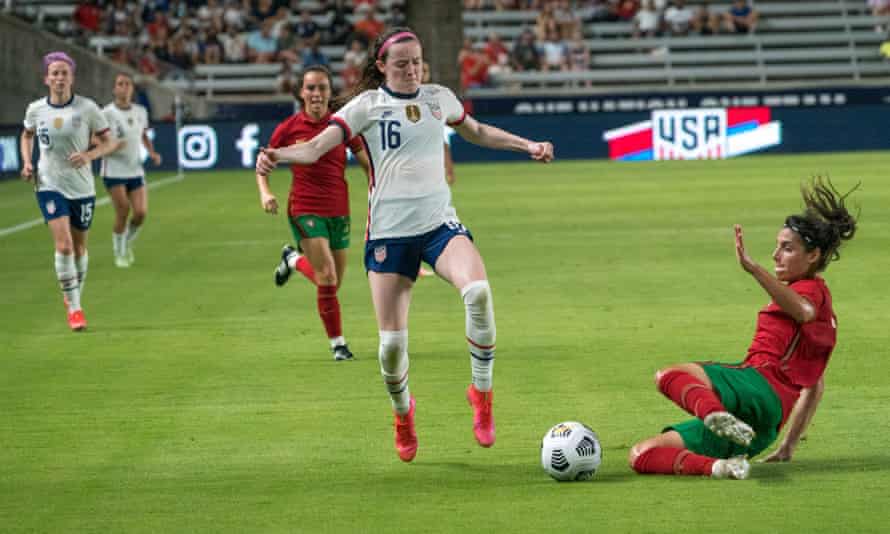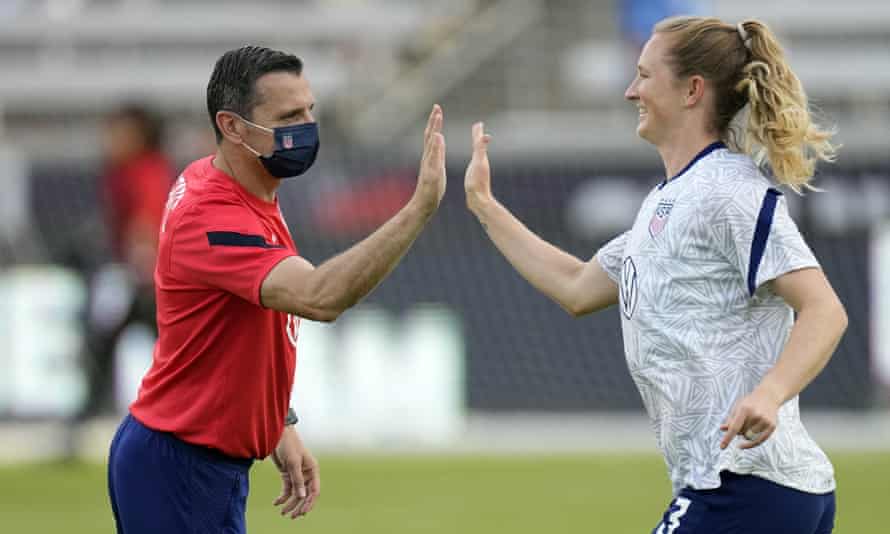
If the US are going to become the first team to win a Women’s World Cup followed by Olympic gold, we now know the squad that will do it. But how does the current squad compare to the one that crashed out at the 2016 Olympics for the USWNT’s worst-ever major tournament finish? Here is a look at how the 2021 squad competing at the Tokyo Olympics stack up against the 2016 group.
GOALKEEPERS
2016: Hope Solo, Alyssa Naeher | Score: 8/10
2021: Alyssa Naeher, Adrianna Franch | Score: 6/10
One of the most surprising choices from coach Vlatko Andonovski was the exclusion of veteran Ashlyn Harris in favor of Franch as Naeher’s back-up
Franch has been, at times, the best goalkeeper in the NWSL, but the lingering question is her experience. The Olympics, a quick-six game tournament for the finalists, isn’t likely to offer a back-up goalkeeper the time to ease in. Franch has just five caps – three of them were blowout victories for the US where she probably could have knitted an actual cap with the downtime she had in goal, and one was her debut, where she made an error that allowed England to score en route to a draw.
But the same could have been said in 2016 about Naeher, who made the Olympic roster despite having just seven caps at the time. Ultimately, it didn’t really matter since Solo played every minute of the tournament.
The starting goalkeeper matters most, and Naeher proved her doubters wrong, in part, by saving a penalty at the 2019 World Cup in France. But, even if Solo did make a couple of mistakes at the 2016 Olympics, she also had moments of brilliance and is considered by many to be the greatest goalkeeper in the USWNT history. Naeher has a lot more to prove to be in that conversation.
DEFENDERS
2016: Whitney Engen, Julie Johnston, Meghan Klingenberg, Ali Krieger, Kelley O’Hara, Becky Sauerbrunn | Score: 7/10
2021: Abby Dahlkemper, Tierna Davidson, Crystal Dunn, Kelley O’Hara, Becky Sauerbrunn, Emily Sonnett | Score: 7/10
The two groups look relatively similar, despite very different personnel: solid defensively, while lacking fullback depth that may or may not become a problem. The difference between the two is how much more attack-oriented the 2016 players were. While Klingenberg and O’Hara were best at bombing forward to create chances for others, Ertz (then Johnston) was deadly when she took them herself, particularly with her head, and Krieger could provide service too.
This time around, the USWNT have fewer capable options for attacking from the back. It may not matter: Dunn is not listed among the 2016 defenders, but that’s only because she made the team as a forward, which should hint at what she brings to the backline. But aside from Dunn and O’Hara, the USWNT’s defense probably won’t pack as much of a punch in Tokyo.
The current backline is more experienced though. The 2016 group had just 314 caps collectively when the roster was announced, compared to 593 this time. In Andonovski’s system, that ought to help.
MIDFIELDERS

2016: Morgan Brian, Tobin Heath, Lindsey Horan, Carli Lloyd, Allie Long, Megan Rapinoe | Score: 4/10
2021: Julie Ertz, Lindsey Horan, Rose Lavelle, Kristie Mewis, Samantha Mewis | Score: 9/10
The absence of Rapinoe, Heath and Lloyd for Tokyo says more about how USWNT tactics have changed than anything else. Back in 2016, they played a 4-4-2 with an ad-hoc central midfield, and now they play a 4-3-3 with a clearer delineation of duties. Rapinoe, Heath and Lloyd are forwards this time around while the midfield is stacked with players who fit the new system.
In Lavelle and Ertz, the USWNT arguably have the best playmaker and the best defensive midfielder in the world, as long as Ertz comes back successfully from an MCL strain she suffered last month. Samantha Mewis and Horan are both superb in the shuttling box-to-box midfielder spot. All the players excel in their given positions, but are well-rounded enough on both sides of the ball to slot in anywhere in the midfield.
The surprise of the group is Kristie Mewis, who only emerged as a candidate for the Olympic team in November. Her distinct advantage is her versatility, a crucial factor on a roster of just 16 field players. She has played as both a defender and attacker in the NWSL, and can play backup wherever Andonovski may need her.
FORWARDS
2016: Crystal Dunn, Alex Morgan, Christen Press, Mallory Pugh | Score: 6.5/10
2021: Tobin Heath, Carli Lloyd, Alex Morgan, Christen Press, Megan Rapinoe | Score 8.5/10
Here is where we see 2016 midfielders Rapinoe, Heath and Lloyd return, and the most important one to discuss is Rapinoe. She proved herself as the best player in the world in 2019 and became a global superstar, but that’s not what makes Rapinoe such an upgrade this time around.
Rather it’s that in 2016, then-coach Jill Ellis selected Rapinoe even though she hadn’t yet recovered from a torn ACL. In Rio, Rapinoe played her first competitive game in 289 days. It was risky, and the gamble didn’t pay off for Ellis, who ultimately wasted two substitutions while bringing a not-yet-fit Rapinoe on and off as a substitute in that fateful quarter-final loss to Sweden. A healthy Rapinoe this time around is an instant upgrade.
Add in Morgan, Press and Lloyd, who are all in good form, and the USWNT should rain down goals in Tokyo. Much has been made of Lloyd’s age – at 39, she will be the oldest player to ever represent the USWNT at an Olympics – but she claims she is in the best form of her life. Her production doesn’t quite back that claim up, but it doesn’t matter – Lloyd has always been a big-game player anyway.
The only question mark is Heath, who has been injured since January, but Andonovski said last week she is almost ready to come back.
COACH

2016: Jill Ellis | Score: 7/10
2021: Vlatko Andonovski | Score: 8/10
With back-to-back World Cup trophies in 2015 and 2019, Ellis’s record looks unimpeachable – except for a blip in 2016, when she steered the USWNT to a quarter-final exit in Rio, the team’s worst-ever finish in a major tournament. And that failure wasn’t a fluke, but mismanagement from Ellis.
After all, in 2015 she made mistakes she was never really punished for and she repeated them again in 2016: she stuck to a predictable attacking system, didn’t put players in their best positions, and brought players that didn’t contribute while other positions lacked depth. To Ellis’s credit, she learned a lot from that Olympic failure and it prompted the changes that helped her win the World Cup in 2019.
Now, Andonovski gets to build on that, and he has implemented ideas to make the USWNT more dynamic than they were back in 2016. Players are given more freedom in the attack to interchange and rotate, gravitating toward the pockets of space they find. Well-drilled triggers and patterns keep the USWNT on the move with cover behind. Winning the ball in dangerous areas from disciplined pressing and counter-pressing is a hallmark of his system.
Andonovski gets a better rating than Ellis not because he is a better USWNT coach – he hasn’t amassed enough results to have that debate, and style points aren’t worth much – but simply because he has the advantage of learning from everything Ellis did wrong in that 2016 disaster and everything she did right in that 2019 triumph. It appears he has been doing just that.
OVERALL
2016: 32.5/50
2021: 38.5/50
The current USWNT should outdo the previous squad and reach the gold medal match, as they have in every other Olympics aside from 2016. Player-for-player, this roster has fewer weaker links than five years ago, with goalkeeping the notable exception. But the improved tactics that influenced a very different roster composition this time around will likely be the deciding factor if the USWNT win gold again, which they look poised to do.
